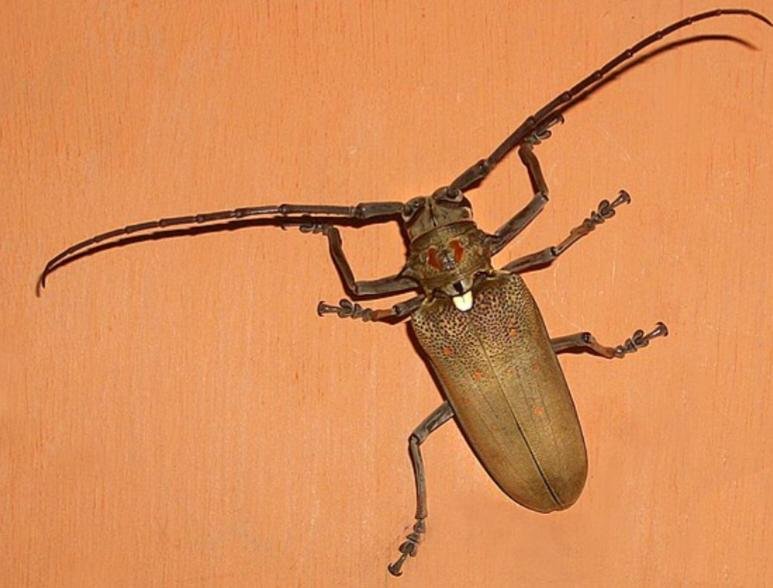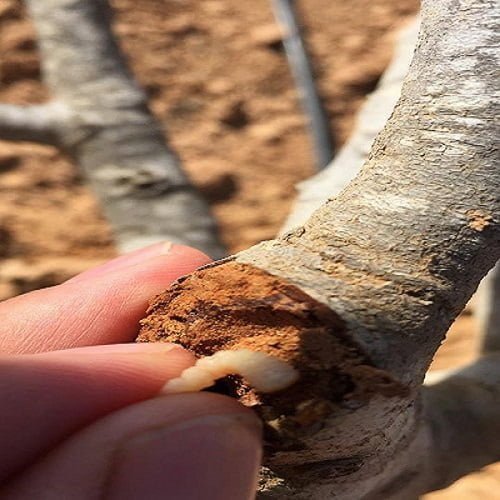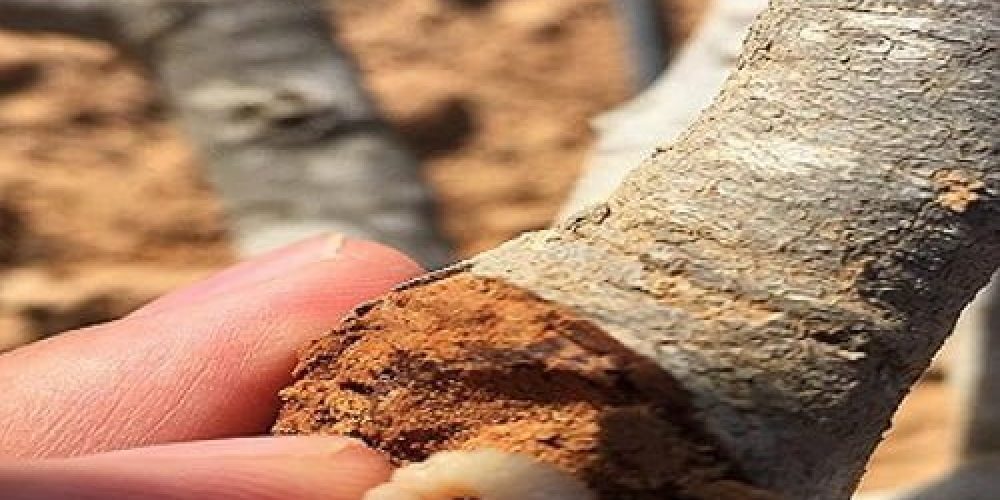Table of contents of the article
Toggle
The tropical fig stem borer is a serious pest that affects fig trees. In this article on your website, World of Plants, we discuss how to identify this insect and ways to combat it.
Description of the fig stem borer insect and its life cycle
- Scientific name: Batocera Ruformaculata Dgree
- The tropical fig stem borer is a large, dark blue beetle with long antennae that exceeds its body length of 5-6 cm. The jaws are strong and the thorax is characterized by the presence of two prominent lateral spines.
- It is a member of the family of long-horned diggers, Ceramby cidae, of the Coleoptera order.
- Its length is more than 5 cm, and its horns are longer than it, and its color is bluish-black. Adult insect: A large dark blue beetle with long antennae that exceeds the length of its adult body by 5-6 cm. The jaws are strong and the thorax is characterized by the presence of two prominent lateral spines.
- The larva is white, cylindrical in shape, with a dark brown head. Its length when fully grown is approximately 10 cm.

Introduction to the fig stem borer insect
- The adult insect appears during the month of June, and during its flight at night it is attracted to the lights near it.
- The female lays her eggs over periods that may extend for weeks, 2-3 eggs per night, inside tree cracks.
- After hatching, the larvae feeds on the layer under the bark for about three months, then digs its tunnels deep into the wood and remains there until the beginning of the second summer, to emerge as a complete insect, repeating its life cycle.
Damage of the fig stem borer insect
- The damage is limited to the tunnels that the larvae dig in the area of the stem and large branches with a diameter of 8 cm, as well as the erosion caused by the adult insect in the surface peel of the stem and the newly formed fruits. The damage intensifies to the point of danger when there are a number of larvae (6-7) on one stem, and they die. The tree after its production declines
Symptoms and damage of the fig stem borer insect
- The larvae dig wide tunnels in the tree trunk and its main branches that are more than 8 cm in diameter. When the number of larvae in one tree reaches 6-7 larvae, the tree dies within three months. The presence of a smaller number of larvae causes weak tree growth and low yields.
- Symptoms are also characterized by the appearance of erosion in the surface bark of young fig trees and newly formed fruits, due to the action of the adult insect, and 2 cm long threads made of clumped sawdust dyed red emerge from the tunnel openings and collect at the tree trunk.
Factors that encourage infection with the fig stem borer pest
There are 5 reasons why fig trees become infected with it:
- The farmer’s lack of familiarity with how to grow figs and prepare the orchard well and properly.
- Farmers' neglect of the amounts of fertilizer added, or improper fertilization, weakens trees and their resistance.
- Also, the use of pesticides without a special method or through ignorance and lack of awareness leads to the spread of the harmful effects of pesticides.
- High temperatures and drought greatly encourage this borer.
- The farmer neglected the regular irrigation of fig trees
Prevention and treatment of fig stem borer insect
- Treatment is focused on combating the adult insect before mating, egg laying, and the larvae enter deep into the wood, by collecting the adult insect and killing it, to prevent its reproduction.
- Remove larvae from infected trunk holes using iron wire.
- Prune and destroy the affected branches and apply the cut site with 5% copper oxychloride (50 g/liter of water).
- Several insecticides have been used prophylactically on mature fig and mango trees, either by spraying (at 0.1%) or coating (at 0.5%) the trunk and branches at intervals of 1 – 2 months. Best results were obtained with monocrotophos and voslon, sprayed or painted at monthly intervals.
- Research was conducted in Pakistan in which holes were cleaned and pieces of sponge or cotton measuring 0.15 cm3 were impregnated with 40 percent monocrotophos pesticide and inserted into two or three holes with a diameter of 2 to 2.5 cm in the trunks of major fig and mango trees.
- A maximum of five applications per year of 30 to 60 ml (12-24 ml) of pesticide per hole are needed depending on the level of infestation. About 80 percent control of stem borers (Batocera rufomaculata) was achieved after 12 months of use.
- Aluminum phosphide tablets (3 g/hole) and dichlorvos (0.1% spray) also gave complete control.
- Use Carbofuran 5 at a rate of 3 g per hole mixed with clay.
Fighting fig stem borer
In order to combat the fig stem borer, a number of preventive and remedial measures are followed, as follows:
Preventive control of the fig stem borer insect
- Preventive control is carried out by the farmer’s interest in properly preparing the fig orchard before planting it, in other words, by preparing the soil necessary for planting the fig seedlings.
- The farmer also takes care mainly of calculated and balanced quantities of fertilizers, especially mineral ones. In addition, regular irrigation of fig trees, as well as good pruning, greatly reduce the number of this pest and protect orchards from it.
Therapeutic control of the fig stem borer insect
- Therapeutic control is carried out using the pesticide Parathion methyl, which is sprayed on trees in the summer.
- It is also possible to spray in the summer using the pesticide Cypermethrin. This remedial measure is sufficient to eliminate this scourge to some extent, but prevention is more important than treatment in any case.
Integrated orchard management procedures
Integrated management of the orchard infected with the fig stem borer is carried out through:
- Conduct soil excavation to a depth of about 70 cm before planting figs.
- Then the planting distances are determined accurately, which are 6 m between one row and the other, and at least 4 m between one tree and the next.
- The planting time is in the fall in warm areas, and in the spring in cold areas.
- Nitrogen, phosphorous and potash fertilizers are added in balance.
- The farmer monitors the trees regularly to ensure that they are free of insect and non-insect pests and pathogens.
- The farmer sprays with preventive pesticides if any disease infections are suspected.
- The recommended pesticides, including phosphorus and carbohydrates, are used, and the farmer avoids parathenoid pesticides and hydrogen charcoal derivatives.
In conclusion, we would like to note that we, at the world of plants website, offer you all the necessary services in the world of plants, we provide all farmers and those interested in plants with three main services::-
- Artificial intelligence consulting service to help you identify diseases that affect plants and how to deal with them.
- Blog about plants, plant diseases and care of various crops ... You are currently browsing one of her articles right now.
- An application that provides agricultural consultations to clients, as well as a service for imaging diseases and knowing their treatment for free – Click to download the Android version from Google Play Store، Click to download the IOS version from the Apple App Store.
Sources
Tropical fig stem borer - al-hakem
Fig stem borer - Wikipedia




